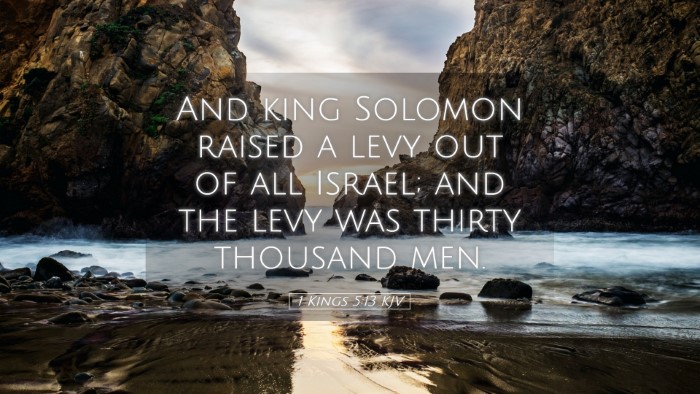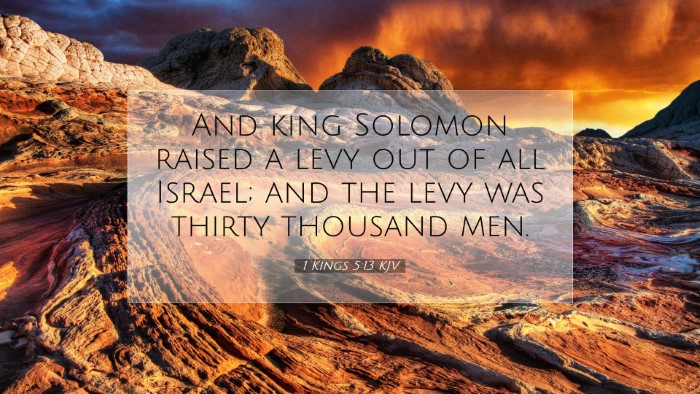Old Testament
Genesis Exodus Leviticus Numbers Deuteronomy Joshua Judges Ruth 1 Samuel 2 Samuel 1 Kings 2 Kings 1 Chronicles 2 Chronicles Ezra Nehemiah Esther Job Psalms Proverbs Ecclesiastes Song of Solomon Isaiah Jeremiah Lamentations Ezekiel Daniel Hosea Joel Amos Obadiah Jonah Micah Nahum Habakkuk Zephaniah Haggai Zechariah Malachi1 Kings 5:13
1 Kings 5:13 KJV
And king Solomon raised a levy out of all Israel; and the levy was thirty thousand men.
1 Kings 5:13 Bible Commentary
Commentary on 1 Kings 5:13
1 Kings 5:13 states: "And king Solomon raised a levy out of all Israel; and the levy was thirty thousand men."
Introduction
This verse marks a significant transition in the life of Israel under King Solomon. It encapsulates the commencement of an extensive project—the construction of the temple in Jerusalem—an undertaking that would demand considerable resources and labor. Engaging insights from Matthew Henry, Albert Barnes, and Adam Clarke, we can discern the multifaceted implications of this verse for the biblical narrative and its theological significance.
Contextual Background
To fully appreciate the weight of 1 Kings 5:13, one must consider the historical and cultural context. Solomon, the son of David, is establishing his reign, and his desire to build a temple reflects a pivotal moment in Israel's national identity and worship. This architectural edifice symbolizes not only a physical space for the worship of Yahweh but also the theological and political aspirations of Solomon’s kingdom.
Matter of the Levy
The 'levy' mentioned encapsulates the employment of a substantial workforce, a strategic move rather than relying exclusively on voluntary labor. This suggests a shift from earlier patterns of communal participation seen during the Israelites' wilderness wanderings and conquest of Canaan to a more organized and hierarchical approach.
Theological Insights
Various commentaries provide nuanced theological reflections on Solomon's actions.
-
Matthew Henry:
Henry emphasizes the providential nature of Solomon's endeavors, suggesting that the raising of the levy showcases God's sovereignty in guiding and providing for the construction of the temple. He advocates that this action reflects both Solomon's wisdom in organization and his undertaking being aligned with divine will.
-
Albert Barnes:
Barnes elaborates on the nature of the levy, asserting that the conscription of thirty thousand men indicates the large scale of the project. He posits that this labor force is indicative of Solomon’s administrative abilities, highlighting a transition from pastoral to a more centralized governance in Israel. This decision arguably signifies both the promise of imminent glory for the temple and the cost of such endeavors.
-
Adam Clarke:
Clarke's commentary notes the outrage that conscription may lead to, recognizing that forced labor could create dissent among the people. He presents this as a period of potential strife contrasted with the glory that the temple would later symbolize. Clarke's historical analysis accentuates the fine balance Solomon had to maintain between his ambitions and his people's wellbeing.
Practical Applications
Incorporating the reflections of these esteemed commentators, the verse prompts several practical applications for contemporary readers, particularly pastors, scholars, and students of the Word.
-
Leadership and Vision:
Solomon's foresight in enlisting a labor force illustrates the importance of vision and planning in leadership. Leaders in various contexts can learn from Solomon's ability to mobilize resources for a greater purpose.
-
The Cost of Obedience:
Compliance with God’s directives, while rewarding, often requires sacrifice. Congregants and religious leaders alike must grapple with the implications of stewardship, recognizing that building the kingdom involves commitments that may not be immediately beneficial.
-
Community and Responsibility:
The duty imposed upon the people through this levy speaks to the collective responsibility believers have in the advancement of spiritual endeavors. The modern church must engage its members actively, recognizing that collective effort yields greater impact.
Conclusion
1 Kings 5:13 serves as a compelling reminder of the organized efforts necessary to fulfill a divine vision within a community. The convergence of administrative wisdom, community engagement, and theological purpose provides a rich framework for understanding how God's plans are often worked out through human structures and systems. As we reflect on Solomon's actions, we are called not only to appreciate the grandeur of the temple but also to recognize the integral role of faithful leadership, communal investment, and the cost of obedience in our ongoing journey of faith.


